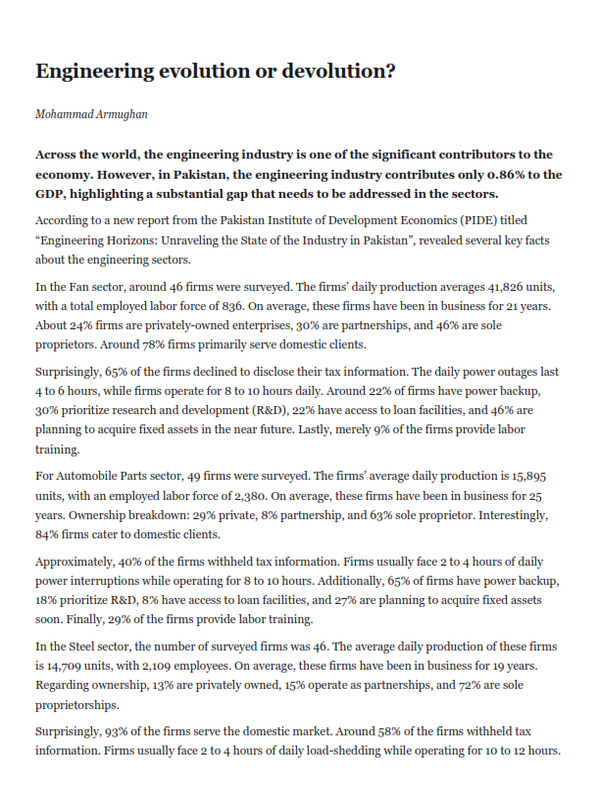Engineering evolution or devolution?
Across the world, the engineering industry is one of the significant contributors to the economy. However, in Pakistan, the engineering industry contributes only 0.86% to the GDP, highlighting a substantial gap that needs to be addressed in the sectors.
According to a new report from the Pakistan Institute of Development Economics (PIDE) titled “Engineering Horizons: Unraveling the State of the Industry in Pakistan”, revealed several key facts about the engineering sectors.
In the Fan sector, around 46 firms were surveyed. The firms’ daily production averages 41,826 units, with a total employed labor force of 836. On average, these firms have been in business for 21 years. About 24% firms are privately-owned enterprises, 30% are partnerships, and 46% are sole proprietors. Around 78% firms primarily serve domestic clients.
Surprisingly, 65% of the firms declined to disclose their tax information. The daily power outages last 4 to 6 hours, while firms operate for 8 to 10 hours daily. Around 22% of firms have power backup, 30% prioritize research and development (R&D), 22% have access to loan facilities, and 46% are planning to acquire fixed assets in the near future. Lastly, merely 9% of the firms provide labor training.
For Automobile Parts sector, 49 firms were surveyed. The firms’ average daily production is 15,895 units, with an employed labor force of 2,380. On average, these firms have been in business for 25 years. Ownership breakdown: 29% private, 8% partnership, and 63% sole proprietor. Interestingly, 84% firms cater to domestic clients.
Approximately, 40% of the firms withheld tax information. Firms usually face 2 to 4 hours of daily power interruptions while operating for 8 to 10 hours. Additionally, 65% of firms have power backup, 18% prioritize R&D, 8% have access to loan facilities, and 27% are planning to acquire fixed assets soon. Finally, 29% of the firms provide labor training.
In the Steel sector, the number of surveyed firms was 46. The average daily production of these firms is 14,709 units, with 2,109 employees. On average, these firms have been in business for 19 years. Regarding ownership, 13% are privately owned, 15% operate as partnerships, and 72% are sole proprietorships.
Surprisingly, 93% of the firms serve the domestic market. Around 58% of the firms withheld tax information. Firms usually face 2 to 4 hours of daily load-shedding while operating for 10 to 12 hours. Additionally, 67% of the firms have electricity backup, 11% focus on R&D, 8% have access to loan facilities, and 27% are planning to acquire fixed assets shortly. Only 16% of the firms provide labor training.
Around 65 firms were surveyed for Pumps and Motors sector. The daily production of these firms is 27,590 units, with 1,068 employees. On average, these firms have been in business for 24 years. Around 29% are privately owned, 15% operate as partnerships, and 56% are sole proprietors. Around 78% of the firms serve domestic market.
More than 49% of the firms withheld tax information. On average, daily load-shedding of 2 to 4 hours, firms operate for 8 to 10 hours each day. Moreover, 60% of the firms have electricity backup, 17% focus on R&D, 9% have access to loan facilities, and 29% are planning to acquire fixed assets in future. Lastly, 15% of the firms provide labor training.
In the Cutlery and Utensils sector, 61 firms were surveyed. Firms’ average daily production is 19,934 units, with an employed labor of 858. On average, these firms have been in operation for 19 years. Ownership breakdown: 23% private, 13% partnership, and 64% sole proprietor.
Nearly, 72% firms primarily serve domestic clients. About 45% firms hoard tax information. On a typical day, firms experience 2 to 4 hours of load-shedding and operate for 8 to 10 hours. Furthermore, 59% of firms have power backup, not a single firm prioritise R&D; merely a 5% have access to loan facilities, and 21% are planning to acquire fixed assets soon. Importantly, none of the surveyed firms provides labor training.
For Furniture sector, the surveyed firms numbered 50. The average daily production of these firms is 716 units, with 266 employees. These firms have been in business for 6 years. Based on surveyed firms, around 96% are sole proprietors and 4% are partnerships. Surprisingly, 100% of the firms serve local market and withheld tax information.
Generally, firms face daily load-shedding of 1 to 2 hours, with operational hours from 11 to 14 each day. Additionally, 20% of the firms have electricity backup, but none of them emphasizes R&D or has access to loans. Around 54% firms are planning to acquire fixed assets shortly, yet none offers labor training.
In the Ceramics & Sanitaryware sector, 11 firms were surveyed. Firms’ average daily production is 2,580 units, with 223 employees. On average, these firms have been in business for 20 years. Regarding ownership, 27% firms’ are owned privately, 18% are partnerships, and 55% are sole proprietors. Astonishingly, 100% of the surveyed firms serve the local market.
Around 64% firms hid tax information. Firms encounter daily load-shedding of 2 to 4 hours, while operating8 to 10 hours. Additionally, 55% of the firms have electricity backup, none promotes R&D or has access to loan facilities, and 27% plan to acquire fixed assets in the future. None of the surveyed firms conducts labor training.
In a nutshell, respondent firms have demonstrated a trust deficit between businesses and government by withholding tax information. They have also highlighted a significant issue of power load-shedding, which costs millions of rupees to firms. Another concerning factor is that most of the firms primarily cater to the domestic market, meaning they have no international clients to serve, no access to international markets, and lack competitive products capable of competing internationally, ultimately contributing to an export deficit engineering industry.
Copyright Business Recorder, 2023




